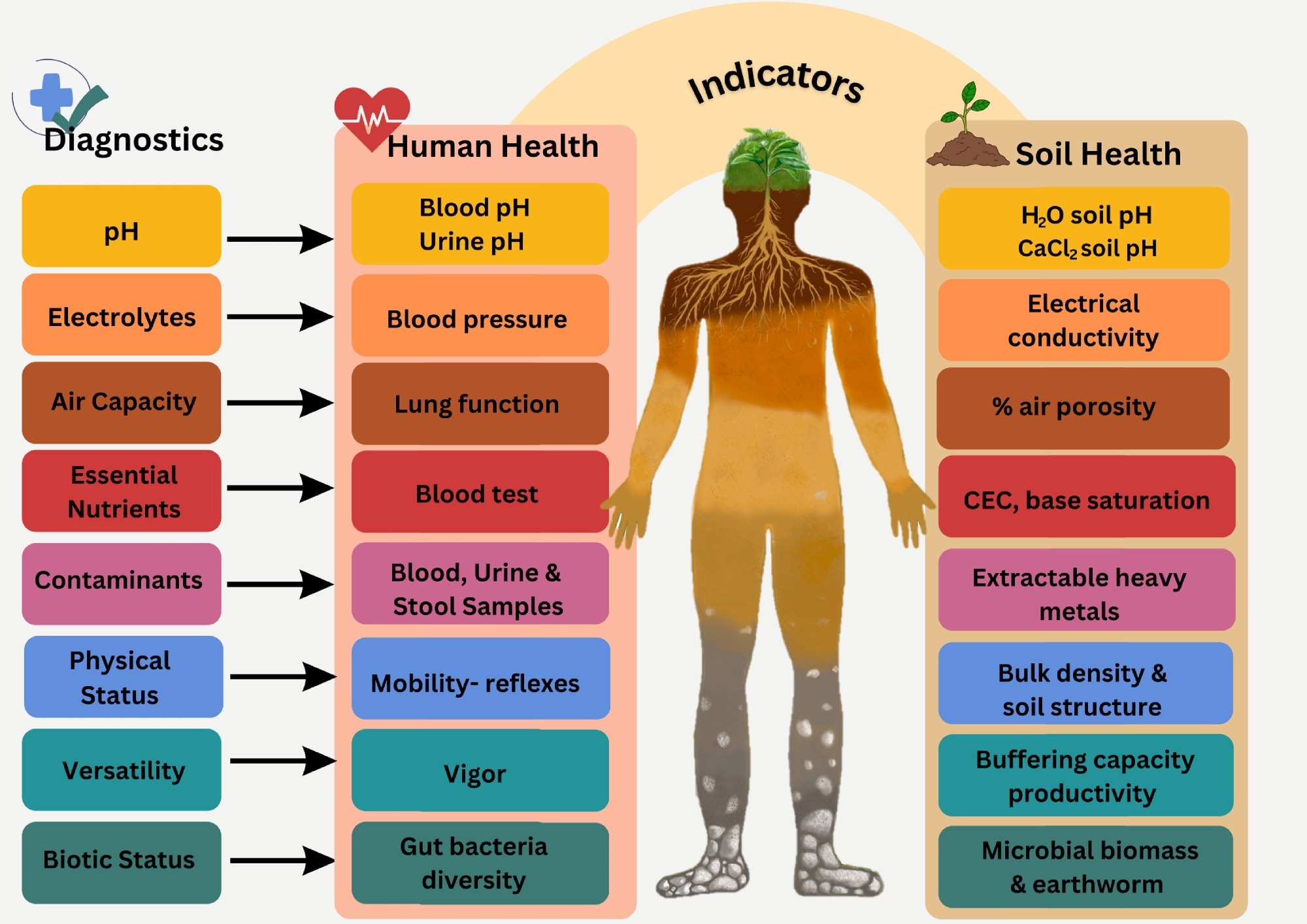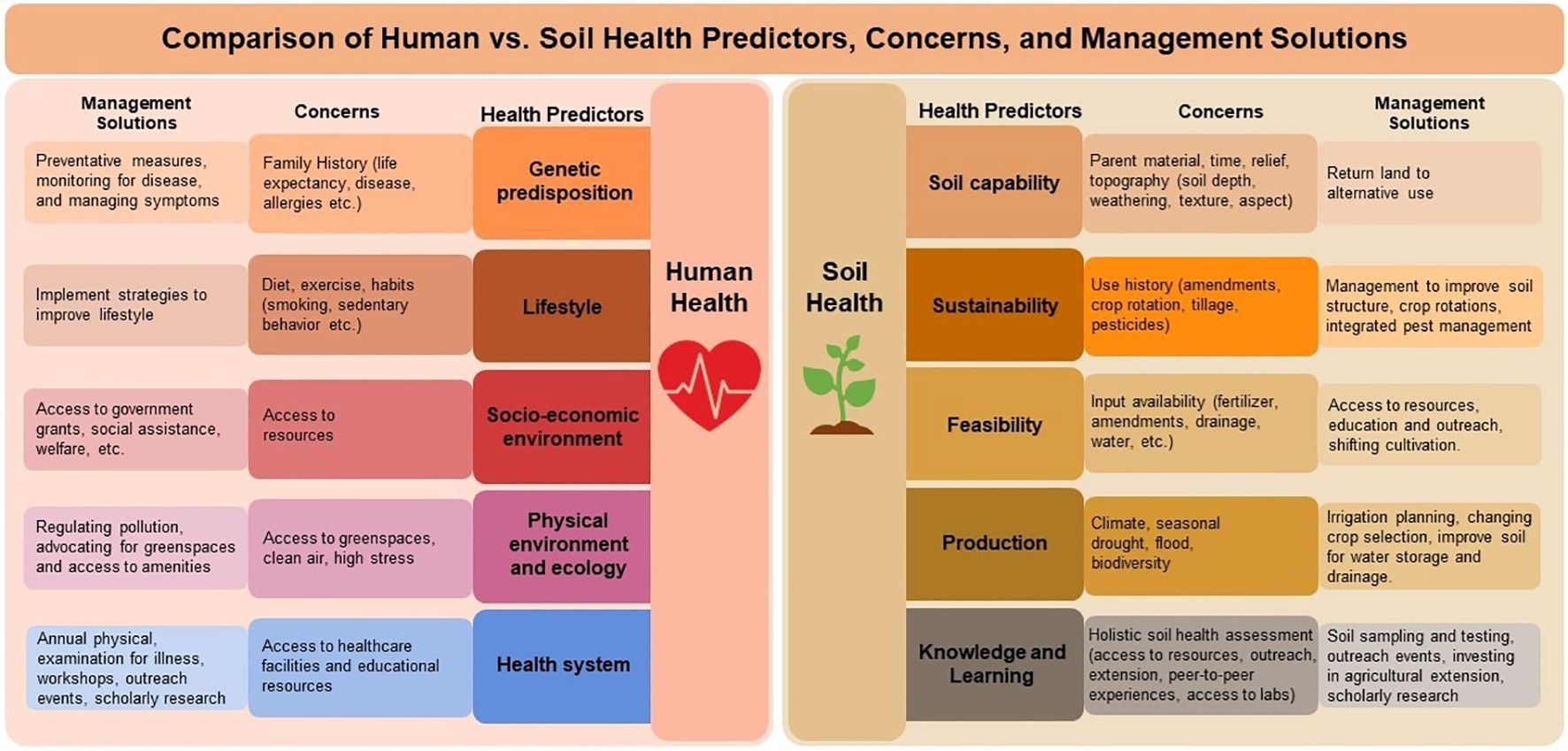What is soil and soil health?
Soil is the biologically active medium that forms the upper-most layer of the Earth's crust and serves as one of the principal substrata supporting life. Colloquially termed 'dirt,' soil is a complex material composed of locally varying inorganic minerals, organic matter (SOM), living organisms, water, and gases. While the ecosystem services of soil have been recognized for thousands of years, the concept and importance of its health remain the subject of extensive scientific debate.
"…although there has been a World Soil Day since 2014, there is still no consensus on a shared definition of 'healthy soil'." The International Technical Panel on Soils historically defined 'soil health' as "the ability of the soil to sustain the productivity, diversity, and environmental services of terrestrial ecosystems." Unfortunately, this definition underscored the service that soil provides but not the characteristics that allow the provider (soil) to do so, leading to this definition being withdrawn in 2020. The present review expands on this by comparing the assessment of human health—based on various physical and biological indicators like blood tests or organ function—with soil health indicators such as soil organic matter, microbial biomass, and nutrient levels.
About the review
The present review aims to collate and synthesize historical and current knowledge on soil's importance in terms of the associations between its use/management and global food/human health outcomes. It employs a novel framework in which human health is used as an analogy for soil health. The review underscores the need for baseline evaluations of 'normal' soil functioning and highlights the need for symptomatic indicators that suggest declining soil health. For example, just as human illness might be diagnosed through symptoms like fatigue or pain, declining soil health can be identified through indicators like reduced microbial activity, increased compaction, or erosion. This would allow for the development of management interventions to restore soil to its normal baseline, analogous to clinical interventions against unhealthy symptoms in humans.
 Comparison of several diagnostics that can be used to assess various indicators of human and soil health.
Comparison of several diagnostics that can be used to assess various indicators of human and soil health.
Soil health versus soil functioning
Soil is a complex material formed by the degradation of rocks over millions of years and is thus a nonrenewable, finite resource. Its importance, however, cannot be understated—it is estimated to support 25% of global biodiversity, comprise the world's largest terrestrial carbon pool (a significant natural adaptation against climate change), and functionally provide humans with more than 95% of their food requirements. According to the review, soil with good health can store carbon, cycle nutrients, and provide water retention, while degraded soils lose these capabilities.
"A citation from Sanskrit scriptures written around 1500 BC states, "Upon this handful of soil our survival depends. Husband it and it will grow our food, our fuel and our shelter and surround us with beauty. Abuse it, and soil will collapse and die, taking humanity with it."
Unfortunately, anthropogenic impacts are significantly (and, at times, irreversibly) altering the composition of the soil, thereby adversely affecting its functioning and signifying its declining health. The review highlights that practices like the overuse of pesticides, excessive fertilizer application, and soil compaction have been primary drivers of degradation, resulting in reduced organic matter, erosion, and greenhouse gas emissions.
 A comparison of human health to soil health using common predictors of human health, including genetic predisposition, lifestyle, socio-economic environment, and ecology and the health system relating them to soil.
A comparison of human health to soil health using common predictors of human health, including genetic predisposition, lifestyle, socio-economic environment, and ecology and the health system relating them to soil.
Why is soil health declining, and how bad is it?
Human populations have expanded at unprecedented rates, requiring more living spaces and, most importantly, more food. The need for food security has resulted in substantial agricultural intensification in recent decades, highlighted by numerous 'green revolutions' aimed at ramping up agricultural production. Unfortunately, this short-term intervention against the global hunger crisis has ignored its long-term impacts on soil health, resulting in a positive feedback loop of 1. Over-cultivation and pesticide use, 2. Decreased soil biodiversity and organic content, 3. Increased soil degradation due to erosion and compaction, and 4. The escalation of inputs like fertilizers to maintain productivity further degrades the soil.
"…increased cultivation intensity, several-fold increases in pesticide use, and almost 700% increase in inorganic fertilizers have been identified as the major cause in the degradation of soils, e.g., increasing soil erosion, soil compaction, and greenhouse gas emissions." The United Nations Food and Agriculture Organization (FAO) estimates that more than 30% of the Earth's soil cover is hitherto degraded through human use, with climate change exacerbating the condition.
How do we assess and preserve soil health?
To successfully assess soil health, we must first define the term. Unfortunately, since its inception in the 1990s, the distinction between the preexisting 'soil quality' and novel 'soil health' has rarely been established. The current consensus is that the former refers to the ecosystem function of the non-living entity 'soil,' while the latter underscores the importance of soil as a dynamic (living?) resource upon which the biosphere depends.
The present review suggests a framework that includes measurable soil health indicators like soil organic matter (SOM), bulk density, microbial biomass, and cation exchange capacity, alongside indicators for biological activity such as earthworm populations or fungal biodiversity. Developing metrics to evaluate these factors would provide a symptomatic overview of the pressures causing local soil health decline and allow for specialized policies against these pressures.
An increasingly popular concept is 'Sustainable Agriculture.' This concept seeks to introduce site-specific plant and animal production without long-term soil impacts, particularly with respect to soil erosion, nutrient and water recharge, and natural soil biota maintenance (e.g., regenerative agriculture). Regenerative practices, such as minimum tillage, crop rotation, and the use of organic manures, have been shown to improve soil structure, increase water infiltration, and promote microbial diversity, key aspects of sustainable soil management.
Conclusions
The present review postulates that the comparisons and parallels between human- and soil health may formalize the framework of soil analysis while further establishing the recognition of soil's importance. By emphasizing soil health as an analogy to human health—using specific diagnostics and symptomatic interventions—the review provides a pathway for integrating soil conservation into public policy. This would inform public debates on soil conservation while allowing for the scientific classification of soil degradation and initiating steps to preserve and improve soil health for a safer and more secure tomorrow.
Journal reference:
- Fausak, L. K., Bridson, N., Jassal, R. S., & Lavkulich, L. M. (2024). Soil health – a perspective. Frontiers in Soil Science, 4, 1462428. DOI: 10.3389/fsoil.2024.1462428, https://www.frontiersin.org/journals/soil-science/articles/10.3389/fsoil.2024.1462428/full